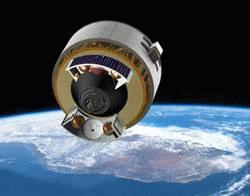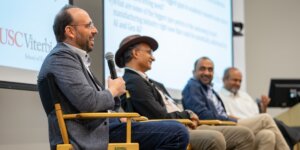USC’s Information Sciences Institute will partner in a new center, directed by ISI Fellow Peter Will, that will work with local aerospace companies to design, build and launch a new, smaller and less expensive class of satellites.
The USC Viterbi School of Engineering has formed the Microsatellite Systems Center which will complement related activities establishing astronautics and space technology degree programs and a capability to build & fly microsatellites in space.

Microsatellite launched by French Ariane 5 rocket. The new USC Microsatellite Systems Center will build, launch and operate such vehicles, weighing less than 100 kg, and teach engineering students the technology involved.
“The aerospace industry currently has a critical shortage of young engineers trained in astronautics and space,” says Viterbi School Dean C.L. Max Nikias. “We believe this center will nurture new engineering talent and allow Southern California to seize the opportunity to become a world center for microsatellites.”
Typically, even “small” satellites today tip the scales at 400 kilograms (880 pounds). “Microsatellites are an exciting domain because miniaturization driven by commercial technology opens up the possibility of less expensive but still highly adaptable satellites with capable payloads,” says MSC director Will, an award winning robotics researcher who will work in partnership with USC’s Astronautics and Space Technology Division at the University Park Campus.

MSC director Peter Will, with an air hockey table used to simulate a zero gravity environment to develop robotic controls that will work in space.
“We think that space research and exploration needs the equivalent transformation in technology and low cost operability that created the personal computer boom&ndash small, low cost, highly flexible vehicles,” says Will.
Specific development under the Center will concentrate on microsatellites around the100 kg (220 pounds) or less class. The Centers research will evaluate microsatellite capabilities in a variety of tasks, from earth imaging, communications, asset and personnel tracking, through applications in space science.
Will said that the challenges involved in the creation of such vehicles requires a team with a broad range of expertise including astronautics, propulsion, instrumentation, computation and control, spacecraft construction, radiation hardening, communications and networking. MSC is the research element of a three-pronged USC effort to develop capabilities within space.
Professor Mike Gruntman, chair of the Viterbi School’s Astronautics and Space Technology Division, notes that the division already has degree programs focused on spacecraft engineering, anchoring USC in an academic focus in this field. Dr Gruntman says the microsatellite initiative “will open new, unique opportunities for students to be involved in real-world advanced space projects.”
Working with Professors Will and Gruntman in the USC Microsatellite Systems Center will be ISI Associate Director for Development Joe Sullivan, ISI Division Director John Damoulakis, and Dan Erwin, associate professor from the Astronautics and Space Technology Division.
A MSC goal is to incorporate new and advanced technologies developed by USC and other partners/companies/agencies and to supplement the effort by using hands-on undergraduate and graduate student participation to integrate and deliver next generation satellites.
The MSC is taking direct advantage of the recent grants won by ISI from NASA, totaling $58 million, and from Dr Gruntman’s work as a co-investigator in NASA space missions, including recently selected Interstellar Boundary Explorer.
These initiatives in combination form a cornerstone for the next generation of USC researchers and engineers to experiment, build and fly exciting missions in space.
Published on March 3rd, 2005
Last updated on June 10th, 2024











